From Seed to System: The Emergence of Non-Manual Markers for Wh-Questions in Nicaraguan Sign Language
Abstract
1. Introduction
2. Methods
2.1. Participants
2.2. Procedure
2.3. Coding
2.4. Statistics
2.4.1. Dependent Variables
2.4.2. Model Specification
3. Results
3.1. Frequency of Non-Manual Occurrence
3.2. Duration of Non-Manual
3.3. Coarticulation of Non-Manual with Wh-Question Word
4. Discussion
Supplementary Materials
Author Contributions
Funding
Institutional Review Board Statement
Informed Consent Statement
Data Availability Statement
Acknowledgments
Conflicts of Interest
| 1. | Following Gagne (2017) and Kocab et al. (2022), we use LSN as the initialism for Nicaraguan Sign Language, reflecting our best information about the community’s current preference for representing the name of the language: Lenguaje de Señas Nicaragüense. Previous initialisms include NSL and ISN. |
References
- Anderson, Diane E., and Judy S. Reilly. 1997. The puzzle of negation: How children move from communicative to grammatical negation in ASL. Applied Psycholinguistics 18: 411–29. [Google Scholar] [CrossRef]
- Bailey, Guy, Tom Wikle, Jan Tillery, and Lori Sand. 1991. The apparent time construct. Language Variation and Change 3: 241–64. [Google Scholar] [CrossRef]
- Bates, Douglas, Martin Maechler, Benjamin Bolker, and Steve Walker. 2015. Fitting linear mixed-effects models using lme4. Journal of Statistical Software 67: 1–48. [Google Scholar] [CrossRef]
- Benitez-Quiroz, C. Fabian, Kadir Gökgöz, Ronnie B. Wilbur, and Aleix M. Martinez. 2014. Discriminant features and temporal structure of non-manuals in American Sign Language. PLoS ONE 9: e86268. [Google Scholar] [CrossRef] [PubMed]
- Benitez-Quiroz, C. Fabian, Ronnie B. Wilbur, and Aleix M. Martinez. 2016. The not face: A grammaticalization of facial expressions of emotion. Cognition 150: 77–84. [Google Scholar] [CrossRef]
- Brentari, Diane, Joshua Falk, Anastasia Giannakidou, Annika Herrmann, Elisabeth Volk, and Markus Steinbach. 2018. Production and comprehension of prosodic markers in sign language imperatives. Frontiers in Psychology 9: 770. [Google Scholar] [CrossRef]
- Bybee, Joan. 2007. Frequency of Use and the Organization of Language. Oxford: Oxford University Press on Demand. [Google Scholar]
- Bybee, Joan. 2010. Language, Usage and Cognition. Cambridge: Cambridge University Press. [Google Scholar]
- Campbell, Ruth, Bencie Woll, Philip J. Benson, and Simon B. Wallace. 1999. Categorical perception of face actions: Their role in sign language and in communicative facial displays. The Quarterly Journal of Experimental Psychology Section A 52: 67–95. [Google Scholar] [CrossRef]
- Coppola, Marie. 2020. Gestures, homesign, sign language: Cultural and social factors driving lexical conventionalization. In Emerging Sign Languages of the Americas. Berlin: De Gruyter Mouton, pp. 349–90. [Google Scholar]
- Coppola, Marie, Susan Goldin-Meadow, and Carolyn Mylander. 2006. How do hearing parents communicate with deaf children? Comparing parents’ speech and gesture across five cultures. Presented at the Meeting of Society for Research on Child Language Disorders, Madison, WI, USA, June. [Google Scholar]
- Costa, Marco, and Pio Enrico Ricci Bitti. 2000. Face-ism effect and head canting in one’s own and others’ photographs. European Psychologist 5: 293. [Google Scholar] [CrossRef]
- Diessel, Holger. 2007. Frequency effects in language acquisition, language use, and diachronic change. New Ideas in Psychology 25: 108–27. [Google Scholar] [CrossRef]
- Domaneschi, Filippo, Marcello Passarelli, and Carlo Chiorri. 2017. Facial expressions and speech acts: Experimental evidences on the role of the upper face as an illocutionary force indicating device in language comprehension. Cognitive Processing 18: 285–306. [Google Scholar] [CrossRef]
- Ekman, Paul. 1979. About brows: Emotional and conversational signals. In Human Ethology. Edited by Mario von Cranach, Klaus Foppa, Wolf Lepenies and Detlev Ploog. Cambridge: Cambridge University Press. [Google Scholar]
- ELAN. 2021. Nijmegen: Max Planck Institute for Psycholinguistics, The Language Archive. (Version 6.2) [Computer Software]. Available online: https://archive.mpi.nl/tla/elan (accessed on 1 July 2021).
- Fridland, Valerie, Kathryn Bartlett, and Roger Kreuz. 2004. Do you hear what I hear? Experimental measurement of the perceptual salience of acoustically manipulated vowel variants by Southern speakers in Memphis, TN. Language Variation and Change 16: 1–16. [Google Scholar] [CrossRef]
- Gagne, D.L. 2017. With a Little Help from My Friends: The Contributions of a Peer Language Network on the Conventionalization of Space in an Emerging Language. Doctoral Dissertations. 1493. Available online: https://opencommons.uconn.edu/dissertations/1493 (accessed on 1 July 2021).
- Goffman, Erving. 1979. Gender Advertisements. New York: Harper and Row. [Google Scholar]
- Goldin-Meadow, Susan. 2005. The Resilience of Language: What Gesture Creation in Deaf Children Can Tell Us about How All Children Learn Language. London: Psychology Press. [Google Scholar]
- Herrmann, Annika. 2015. The marking of information structure in German Sign Language. Lingua 165: 277–97. [Google Scholar] [CrossRef]
- Hudson Kam, Carla L., and Elissa L. Newport. 2005. Regularizing unpredictable variation: The roles of adult and child learners in language formation and change. Language Learning and Development 1: 151–95. [Google Scholar] [CrossRef]
- Hudson Kam, Carla L., and Elissa L. Newport. 2009. Getting it right by getting it wrong: When learners change languages. Cognitive Psychology 59: 30–66. [Google Scholar] [CrossRef] [PubMed]
- Janzen, Terry, and Barbara Shaffer. 2002. Gesture as the substrate in the process of ASL grammaticization. In Modality and Structure in Signed and Spoken Languages. Edited by Richard P. Meier, Kearsy Cormier and David Quinto-Pozos. Cambridge: Cambridge University Press, pp. 199–223. [Google Scholar]
- Kanwal, Jasmeen, Kenny Smith, Jennifer Culbertson, and Simon Kirby. 2017. Zipf’s law of abbreviation and the principle of least effort: Language users optimise a miniature lexicon for efficient communication. Cognition 165: 45–52. [Google Scholar] [CrossRef]
- Kegl, Judy, Ann Senghas, and Marie Coppola. 1999. Creation through contact: Sign language emergence and sign language change in Nicaragua. In Language Creation and Language Change: Creolization, Diachrony, and Development. Cambridge: The MIT Press, pp. 179–237. [Google Scholar]
- Kirby, Simon, Hannah Cornish, and Kenny Smith. 2008. Cumulative cultural evolution in the laboratory: An experimental approach to the origins of structure in human language. Proceedings of the National Academy of Sciences USA 105: 10681–86. [Google Scholar] [CrossRef]
- Kocab, Annemarie, Ann Senghas, and Jesse Snedeker. 2016. The emergence of temporal language in Nicaraguan Sign Language. Cognition 156: 147–63. [Google Scholar] [CrossRef]
- Kocab, Annemarie, Jennie Pyers, and Ann Senghas. 2015. Referential shift in Nicaraguan Sign Language: A transition from lexical to spatial devices. Frontiers in Psychology 5: 1540. [Google Scholar] [CrossRef]
- Kocab, Annemarie, Kathryn Davidson, and Jesse Snedeker. 2022. The Emergence of Natural Language Quantification. Cognitive Science 46: e13097. [Google Scholar] [CrossRef]
- Labov, William. 1963. The social motivation of a sound change. Word 19: 273–309. [Google Scholar] [CrossRef]
- Lüdecke, Daniel. 2021. sjPlot: Data Visualization for Statistics in Social Science. R package version 2.8.9. Available online: https://CRAN.R-project.org/package=sjPlot (accessed on 1 October 2021).
- Lutzenberger, Hannah, Roland Pfau, and Connie de Vos. 2022. Emergence or Grammaticalization? The Case of Negation in Kata Kolok. Languages 7: 23. [Google Scholar] [CrossRef]
- Mayberry, Rachel I., and Susan D. Fischer. 1989. Looking through phonological shape to lexical meaning: The bottleneck of non-native sign language processing. Memory and Cognition 17: 740–54. [Google Scholar] [CrossRef] [PubMed]
- McClave, Evelyn. 2001. The relationship between spontaneous gestures of the hearing and American Sign Language. Gesture 1: 51–72. [Google Scholar] [CrossRef]
- Mesch, Johanna. 2016. Manual backchannel responses in signers’ conversations in Swedish Sign Language. Language and Communication 50: 22–41. [Google Scholar] [CrossRef]
- Petronio, Karen, and Diane Lillo-Martin. 1997. WH-movement and the position of Spec-CP: Evidence from American Sign Language. Language 73: 18–57. [Google Scholar] [CrossRef]
- Pfau, Roland, and Markus Steinbach. 2006. Modality-independent and modality-specific aspects of grammaticalization in sign languages. Linguistics in Potsdam 24: 3–98. [Google Scholar]
- Pfau, Roland, and Markus Steinbach. 2011. Grammaticalization in sign languages. In The Oxford Handbook of Grammaticalization. Edited by Bernd Heine and Heiko Narrog. Oxford: Oxford University Press, pp. 681–93. [Google Scholar] [CrossRef]
- Polich, Laura. 2005. The Emergence of the Deaf Community in Nicaragua: “With Sign Language You Can Learn So Much”. Washington, DC: Gallaudet University Press. [Google Scholar]
- Pyers, Jennie, and Karen Emmorey. 2008. The face of bimodal bilingualism: Grammatical markers in American Sign Language are produced when bilinguals speak to English monolinguals. Psychological Science 19: 531–35. [Google Scholar] [CrossRef]
- R Core Team. 2021. R: A Language and Environment for Statistical Computing. Vienna: R Foundation for Statistical Computing. Available online: https://www.R-project.org/ (accessed on 1 October 2021).
- Reilly, Judy. 2006. How faces come to serve grammar: The development of non-manual morphology in American Sign Language. In Advances in the Sign Language Development of Deaf Children. Edited by Marc Marschark Brenda Schick and Patricia Elizabeth Spencer. Oxford: Oxford University Press, pp. 262–90. [Google Scholar]
- Reilly, Judy Snitzer, MarinaMcIntire, and Ursula Bellugi. 1990. The acquisition of conditionals in American Sign Language: Grammaticized facial expressions. Applied Psycholinguistics 11: 369–92. [Google Scholar] [CrossRef]
- Saffran, Jenny R., Richard N. Aslin, and Elissa L. Newport. 1996. Statistical learning by 8-month-old infants. Science 274: 1926–28. [Google Scholar] [CrossRef]
- Sandler, Wendy. 1999. The medium and the message: Prosodic interpretation of linguistic content in Israeli Sign Language. Sign Language & Linguistics 2: 187–215. [Google Scholar]
- Sandler, Wendy. 2010. Prosody and syntax in sign languages. Transactions of the Philological Society 108: 298–328. [Google Scholar] [CrossRef]
- Sandler, Wendy, and Diane Lillo-Martin. 2006. Sign Language and Linguistic Universals. Cambridge: Cambridge University Press. [Google Scholar]
- Sandler, Wendy, Irit Meir, Svetlana Dachkovsky, Carol Padden, and Mark Aronoff. 2011. The emergence of complexity in prosody and syntax. Lingua 121: 2014–33. [Google Scholar] [CrossRef][Green Version]
- Sankoff, Gillian. 2006. Age: Apparent time and real time. In Encyclopedia of Language and Linguistics. Amsterdam: Elsevier, pp. 110–15. [Google Scholar]
- Senghas, Ann. 2003. Intergenerational influence and ontogenetic development in the emergence of spatial grammar in Nicaraguan Sign Language. Cognitive Development 18: 511–31. [Google Scholar] [CrossRef]
- Senghas, Ann, and Marie Coppola. 2001. Children creating language: How Nicaraguan Sign Language acquired a spatial grammar. Psychological Science 12: 323–28. [Google Scholar] [CrossRef] [PubMed]
- Senghas, Ann, Marie Coppola, Elissa L. Newport, and Ted Supalla. 1997. Argument structure in Nicaraguan Sign Language: The emergence of grammatical devices. In BUCLD 21: Proceedings of the 21st Annual Boston University Conference on Language Development. Edited by Elizabeth Hughes, Mary Hughes and Annabel Greenhill. Boston: Cascadilla Press, pp. 550–61. [Google Scholar]
- Senghas, Richard, Ann Senghas, and Jennie Pyers. 2005. The emergence of Nicaraguan Sign Language: Questions of development, acquisition, and evolution. In Biology and Knowledge Revisited. London: Routledge, pp. 305–24. [Google Scholar]
- Singleton, Jenny L., and Elissa L. Newport. 2004. When learners surpass their models: The acquisition of American Sign Language from inconsistent input. Cognitive Psychology 49: 370–407. [Google Scholar] [CrossRef]
- Swerts, Marc, and Emiel Krahmer. 2005. Audiovisual prosody and feeling of knowing. Journal of Memory and Language 53: 81–94. [Google Scholar] [CrossRef]
- Wickham, Hadley. 2016. ggplot2: Elegant Graphics for Data Analysis. New York: Springer. [Google Scholar]
- Wilbur, Ronnie B. 2013. Phonological and prosodic layering of nonmanuals in American Sign Language. In The Signs of Language Revisited. London: Psychology Press, pp. 196–220. [Google Scholar]
- Zeshan, Ulrike. 2004. Interrogative constructions in signed languages: Crosslinguistic perspectives. Language 80: 7–39. [Google Scholar] [CrossRef]
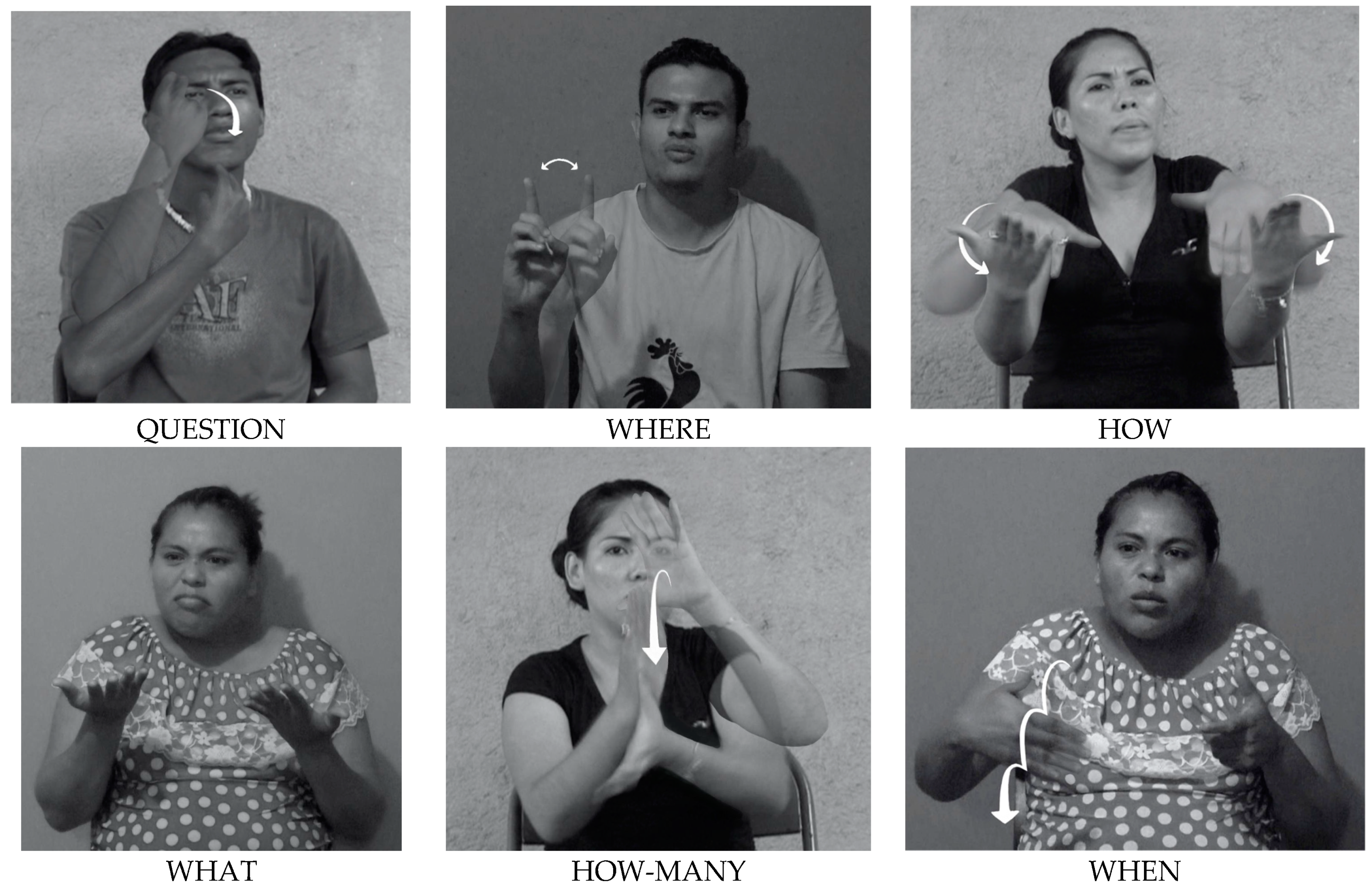
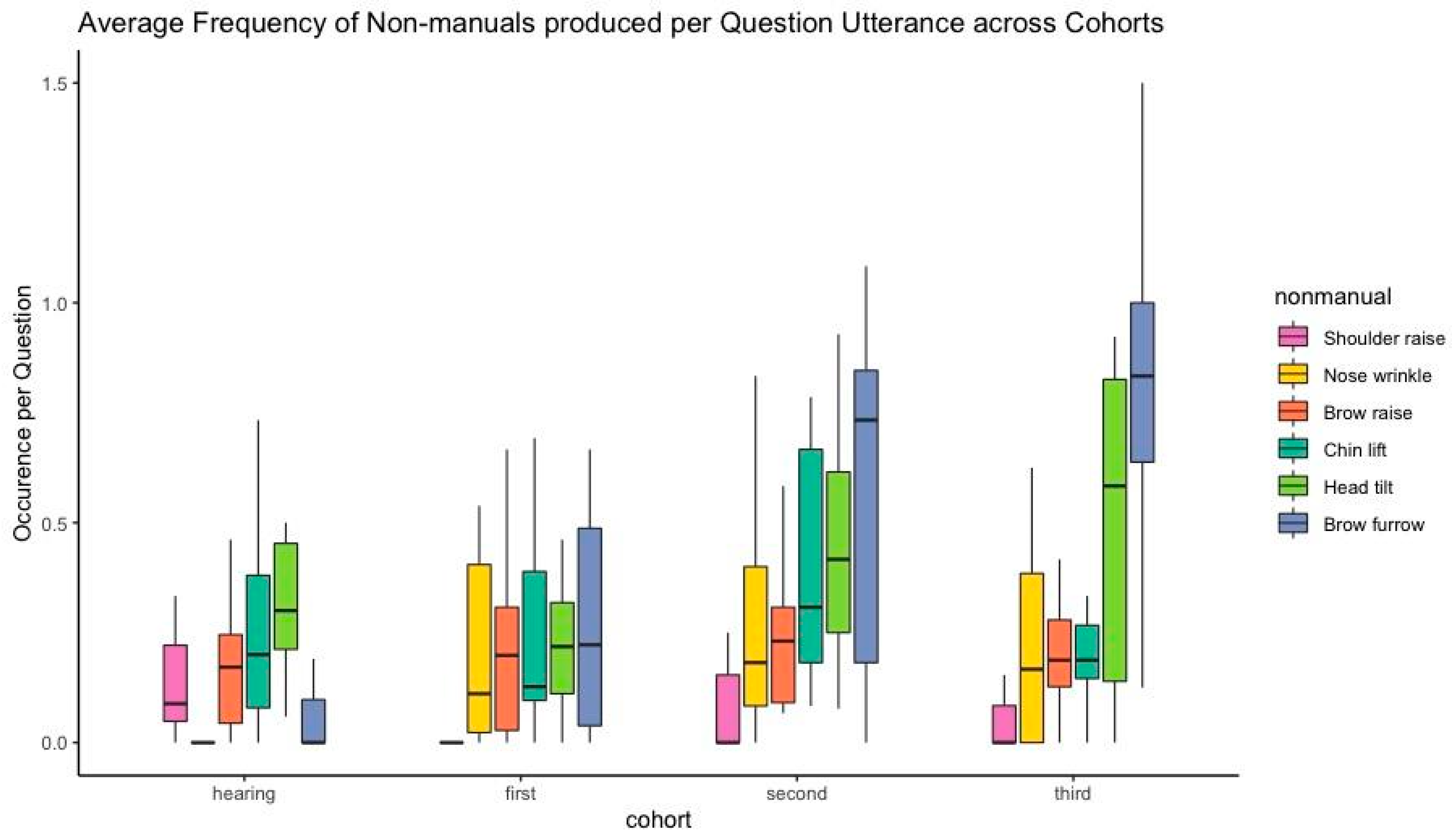
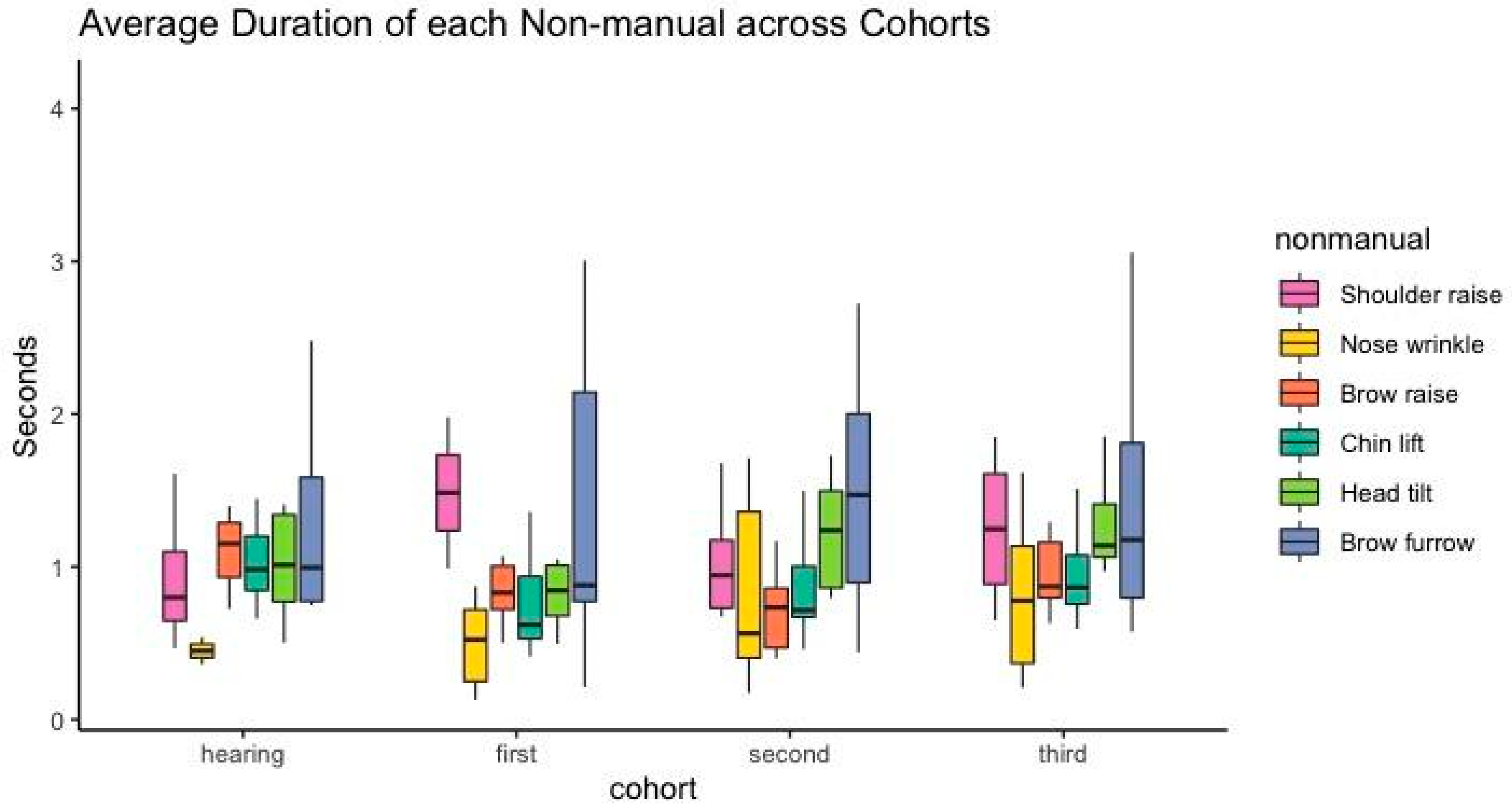
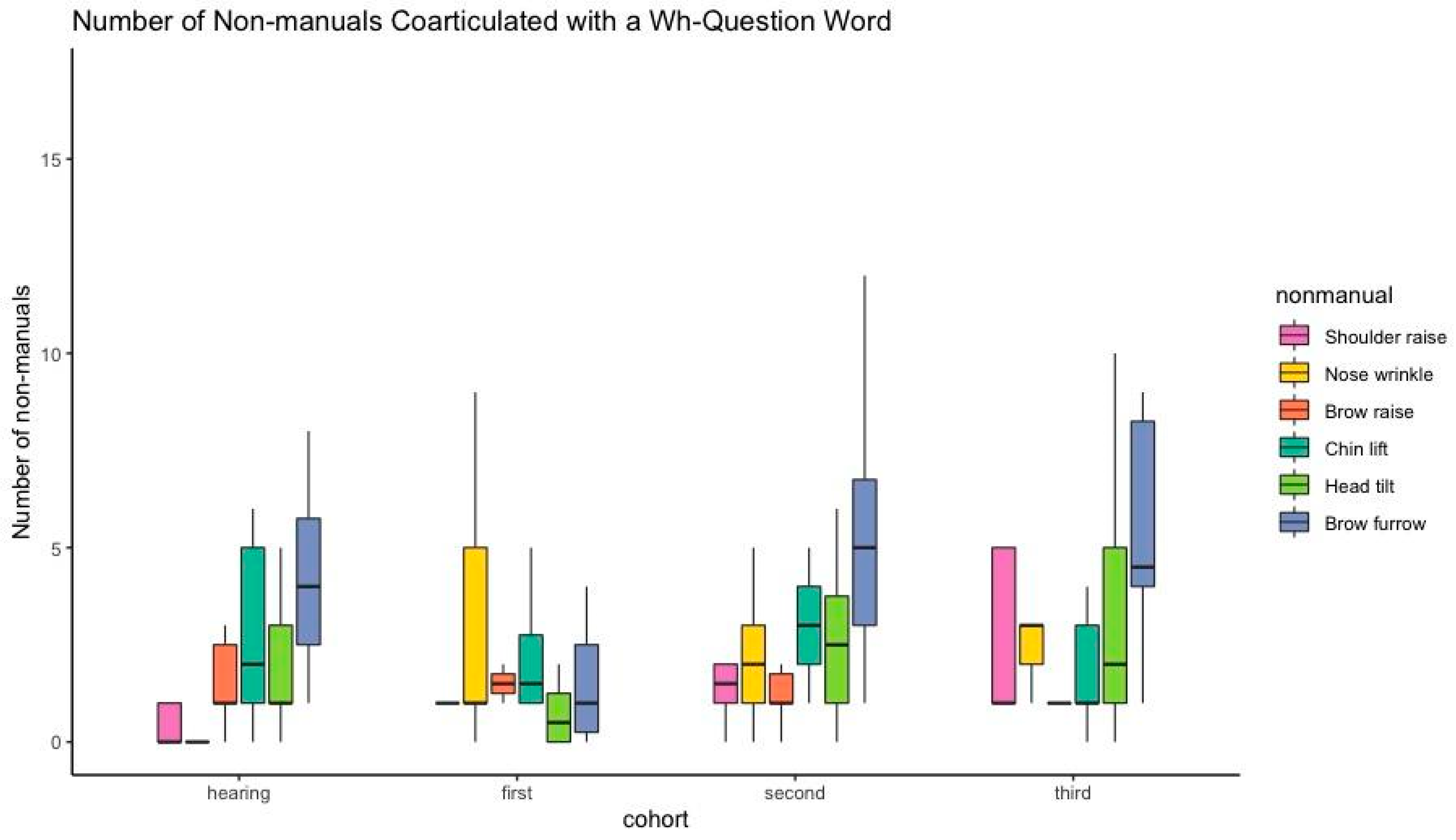
| Cued Information to Be Elicited | Target Wh-Question Word (English Translation) | Target Wh-Question Word (Spanish Translation) |
|---|---|---|
| Name | what | qué |
| Age | how many | cuanto |
| Birthday | when | cuándo |
| Number of siblings | how many | cuanto |
| Job 1 | what | qué |
| Supermarket 1 | where | donde |
| Favorite food 1 | what | qué |
| Home address | where | donde |
| Friend 1 | who, which | quién, cual |
| Transportation to work/school 2 | what | qué |
| Mother’s birthday 2 | when | cuándo |
| Waking time 2 | when | cuándo |
| Dinner time 2 | when | cuándo |
| Name of your teacher/boss 2 | what | qué |
| Bus route nearest your home 2 | where | donde |
| Non-Manual | Description | Example |
|---|---|---|
| Brow Furrow | Corresponds to Ekman’s facial action unit 4 (AU4). Comprises a pulling together of the eyebrows that often is evidenced as vertical wrinkles between the eyebrows. | 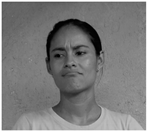 |
| Brow Raise | Corresponds to a combination of Ekman’s facial action units 1 and 2 (AU1 + AU2) where both the inner and outer brow are raised, often resulting in lines on the forehead |  |
| Nose Wrinkle | Corresponds with Eckman’s facial action unit 9 (AU9) which involves a pulling up of the nose and a deepening of the creases on either side of the nostrils, often with a horizontal wrinkle across the bridge of the nose | 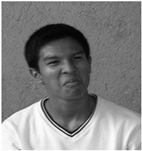 |
| Chin lift | Operationalized as a tilting of the head backwards to raise the chin. (This movement does not correspond with Eckman’s facial action unit 17 “chin raiser.”) | 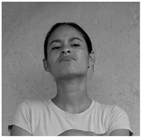 |
| Head tilt | Any tilt of the head to the left or right of a neutral head position, also referred to as a “head cant” (e.g., Goffman 1979) | 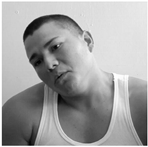 |
| Shoulder raise | Any movement of the shoulder upwards from a neutral position; often looks like a shoulder shrug. | 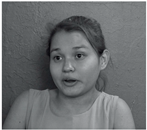 |
| Cohort | Questions | Wh-Question Words | Shoulder Raise | Nose Wrinkle | Brow Raise | Chin Lift | Head Tilt | Brow Furrow |
|---|---|---|---|---|---|---|---|---|
| Hearing (N = 16) | 266 | 200 | 42 | 2 | 49 | 73 | 85 | 28 |
| First (N = 10) | 119 | 67 | 3 | 30 | 28 | 27 | 24 | 31 |
| Second (N = 13) | 165 | 229 | 12 | 50 | 39 | 73 | 73 | 99 |
| Third (N = 11) | 126 | 215 | 22 | 33 | 31 | 35 | 65 | 107 |
| Total Non-Manuals | |||
|---|---|---|---|
| Predictors | Estimates | CI | p |
| (Intercept) | 1.03 | 0.64–1.41 | <0.001 |
| First cohort | 0.28 | −0.33–0.88 | 0.370 |
| Second cohort | 1.08 | 0.53–1.64 | <0.001 |
| Third cohort | 1.22 | 0.64–1.81 | <0.001 |
| Random Effects | |||
| σ2 | 1.14 | ||
| τ00 ID | 0.49 | ||
| τ00 item | 0.05 | ||
| ICC | 0.32 | ||
| N item | 17 | ||
| N ID | 50 | ||
| Observations | 676 | ||
| Marginal R2/Conditional R2 | 0.146/0.419 | ||
| Shoulder Raise | Nose Wrinkle | Brow Raise | Chin Lift | Head Tilt | Brow Furrow | |||||||||||||
|---|---|---|---|---|---|---|---|---|---|---|---|---|---|---|---|---|---|---|
| Predictors | Estimates | CI | p | Estimates | CI | p | Estimates | CI | p | Estimates | CI | p | Estimates | CI | p | Estimates | CI | p |
| (Intercept) | 0.16 | 0.06–0.26 | 0.001 | 0 | −0.11–0.12 | 0.941 | 0.19 | 0.10–0.28 | <0.001 | 0.26 | 0.13–0.39 | <0.001 | 0.32 | 0.20–0.44 | <0.001 | 0.1 | −0.04–0.24 | 0.172 |
| First cohort | −0.14 | −0.30–0.02 | 0.096 | 0.28 | 0.09–0.47 | 0.004 | 0.05 | −0.10–0.20 | 0.494 | −0.01 | −0.22–0.19 | 0.891 | −0.11 | −0.31–0.09 | 0.271 | 0.18 | −0.05–0.41 | 0.128 |
| Second cohort | −0.09 | −0.24–0.06 | 0.248 | 0.29 | 0.12–0.47 | 0.001 | 0.05 | −0.08–0.18 | 0.459 | 0.18 | −0.00–0.37 | 0.056 | 0.13 | −0.06–0.31 | 0.180 | 0.5 | 0.29–0.71 | <0.001 |
| Third Cohort | −0.02 | −0.18–0.13 | 0.762 | 0.24 | 0.06–0.42 | 0.011 | 0.07 | −0.08–0.21 | 0.371 | 0.03 | −0.17–0.22 | 0.804 | 0.19 | −0.00–0.38 | 0.055 | 0.72 | 0.50–0.94 | <0.001 |
| Random Effects | ||||||||||||||||||
| σ2 | 0.08 | 0.16 | 0.2 | 0.23 | 0.22 | 0.19 | ||||||||||||
| τ00 | 0.04 ID | 0.04 ID | 0.02 ID | 0.05 ID | 0.05 ID | 0.07 ID | ||||||||||||
| 0.00 item | 0.00 item | 0.00 item | 0.01 item | 0.00 item | 0.00 item | |||||||||||||
| ICC | 0.33 | 0.22 | 0.09 | 0.18 | 0.18 | |||||||||||||
| N | 17 item | 17 item | 17 item | 17 item | 17 item | 17 item | ||||||||||||
| 50 ID | 50 ID | 50 ID | 50 ID | 50 ID | 50 ID | |||||||||||||
| Observations | 676 | 676 | 676 | 676 | 676 | 676 | ||||||||||||
| Marginal R2/Conditional R2 | 0.025/0.344 | 0.081/0.282 | 0.003/0.096 | 0.021/0.201 | 0.037/0.208 | 0.293/NA | ||||||||||||
Publisher’s Note: MDPI stays neutral with regard to jurisdictional claims in published maps and institutional affiliations. |
© 2022 by the authors. Licensee MDPI, Basel, Switzerland. This article is an open access article distributed under the terms and conditions of the Creative Commons Attribution (CC BY) license (https://creativecommons.org/licenses/by/4.0/).
Share and Cite
Kocab, A.; Senghas, A.; Pyers, J. From Seed to System: The Emergence of Non-Manual Markers for Wh-Questions in Nicaraguan Sign Language. Languages 2022, 7, 137. https://doi.org/10.3390/languages7020137
Kocab A, Senghas A, Pyers J. From Seed to System: The Emergence of Non-Manual Markers for Wh-Questions in Nicaraguan Sign Language. Languages. 2022; 7(2):137. https://doi.org/10.3390/languages7020137
Chicago/Turabian StyleKocab, Annemarie, Ann Senghas, and Jennie Pyers. 2022. "From Seed to System: The Emergence of Non-Manual Markers for Wh-Questions in Nicaraguan Sign Language" Languages 7, no. 2: 137. https://doi.org/10.3390/languages7020137
APA StyleKocab, A., Senghas, A., & Pyers, J. (2022). From Seed to System: The Emergence of Non-Manual Markers for Wh-Questions in Nicaraguan Sign Language. Languages, 7(2), 137. https://doi.org/10.3390/languages7020137






